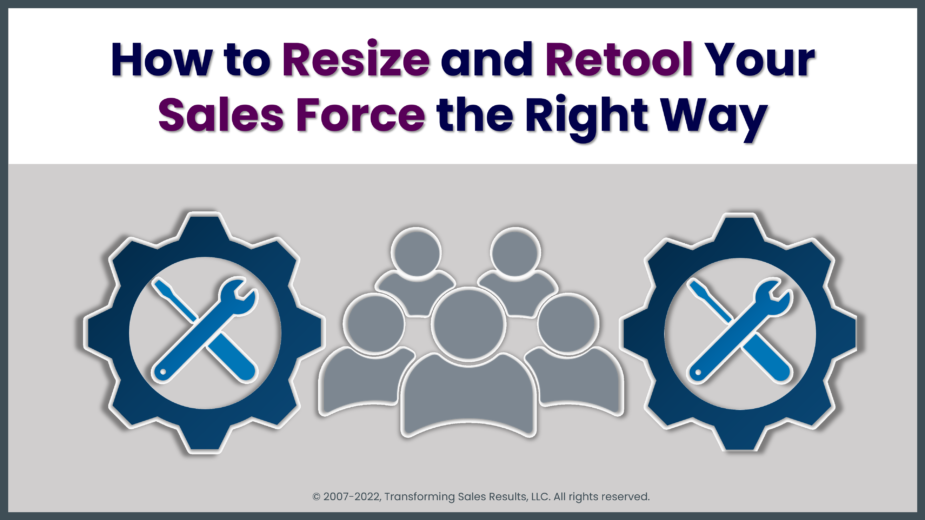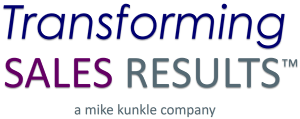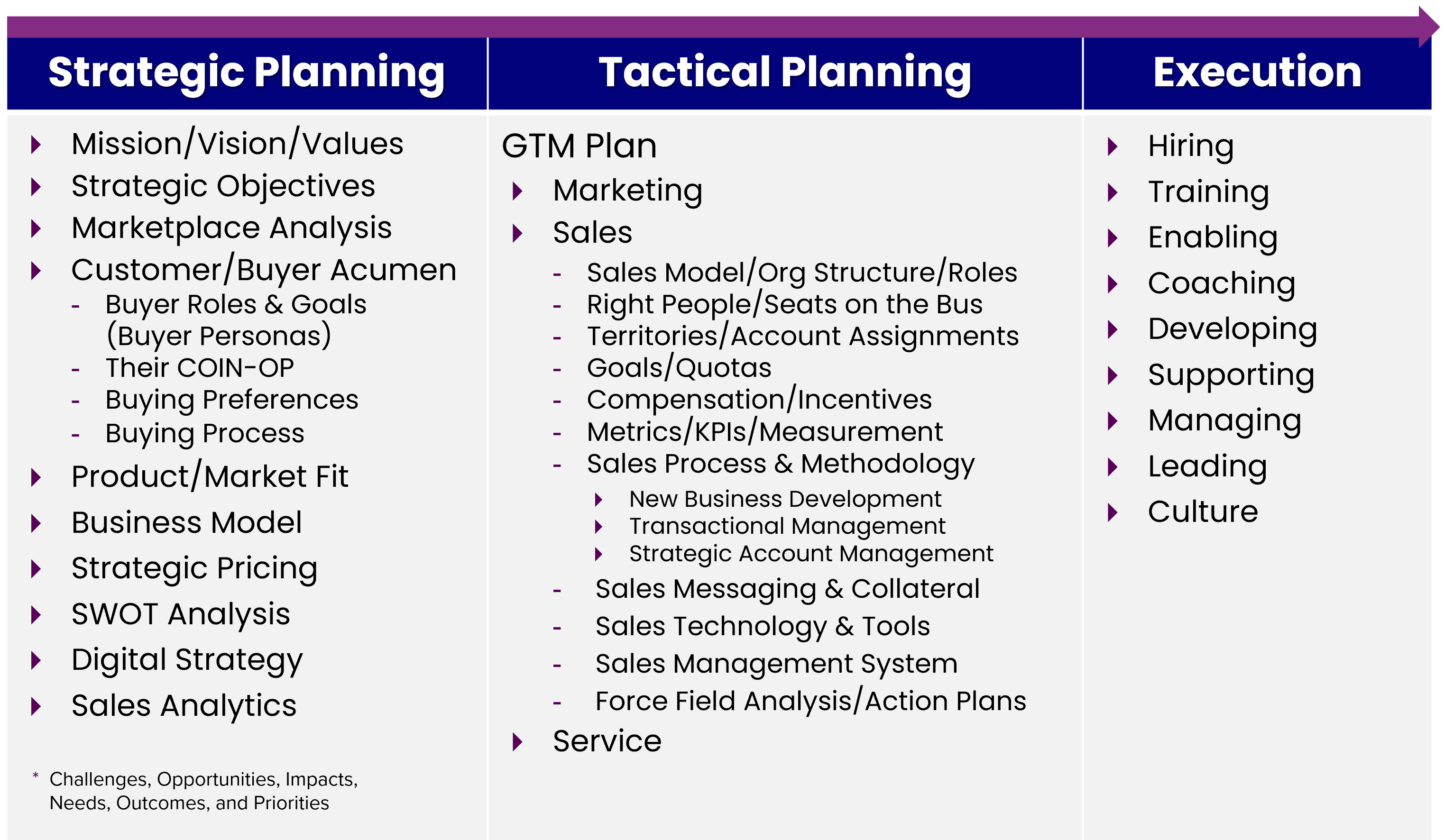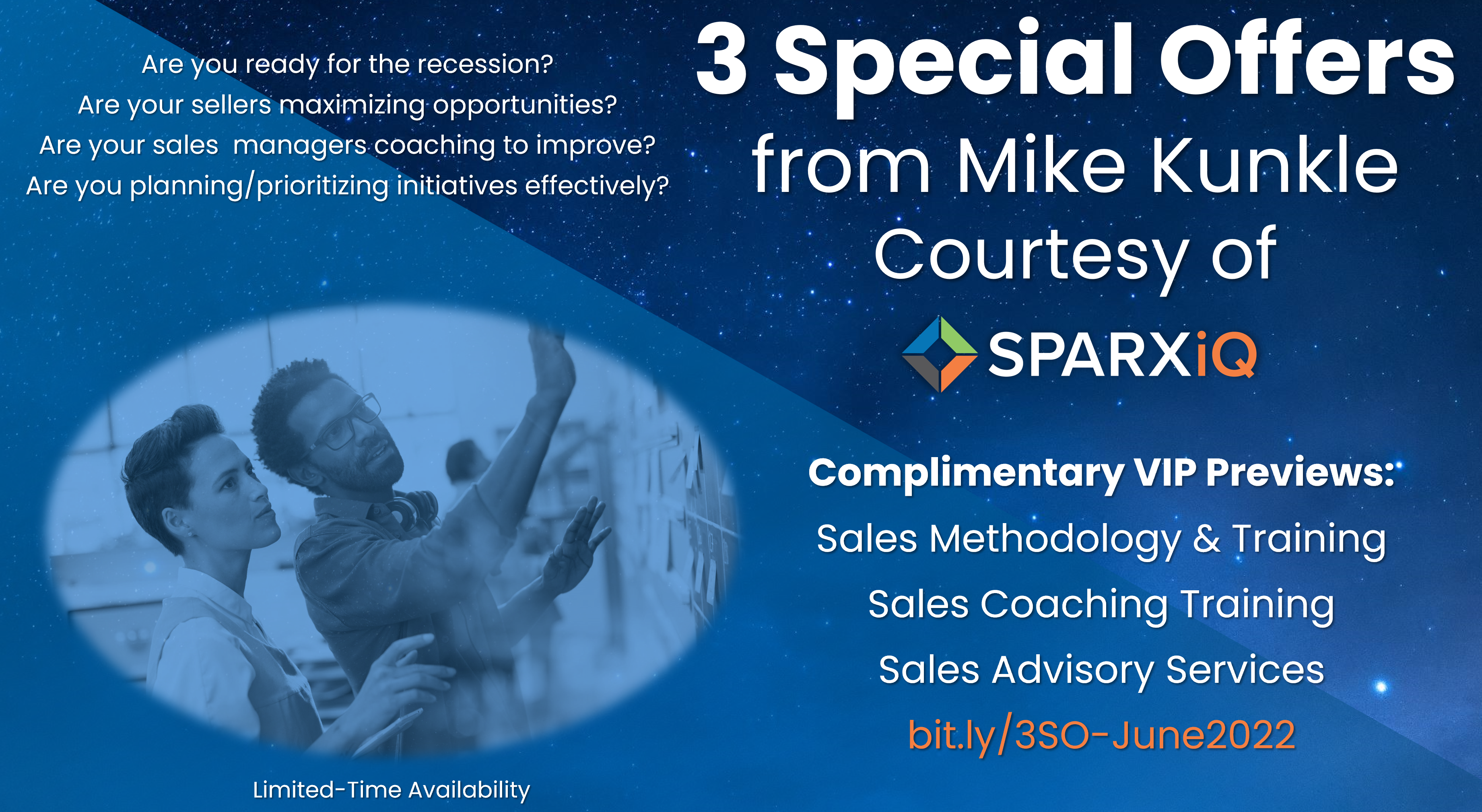How to Resize and Retool Your Sales Force

This is a post I never wanted to write. I originally posted it as a LinkedIn Article in August of 2020 and unfortunately, find it relevant again already in mid-2022. At the time I published it initially, I had hoped the worst of the pandemic-fueled layoffs were behind us. Unfortunately, many company executives still needed to make tough choices, even with their revenue-producing teams. In some cases, it wasn’t the first time that they had to act. Now, facing a blossoming recession, we’re hearing of layoffs, downsizing, cost-cutting, and new hires being told their positions have vaporized. I hope this will contained to not-yet-profitable, seed-funded early-stage companies with burn-rate/runway issues, but as the recession gears up, it may spread.
While I personally believe this is a time when well-managed, profitable firms should double-down on investing in their employees to gain competitive advantage in difficult times (I wrote about this recently on LinkedIn, as well), I know that may not be possible for everyone.
I usually chastise leaders for doing a series of downsizings. In 2020, I applauded them for trying hard not to send people out into the record masses of the unemployed. I’ll never suggest that downsizing someone is as hard as being downsized, but I’ve been on both sides of the desk, and they both suck.
If you absolutely can’t avoid it and find yourself needing to resize and retool your sales force again at this time, I have some advice that I hope might help. People should always come first, but for this post, from your company’s perspective, let’s start with the business stuff.
Strategy First
Even under financial and emotional duress, strive to make calm, thoughtful, strategic decisions. Sometimes, it seems to me as if critical thinking is at an all-time low right now, especially in the sales profession. But at a time like this, you can’t afford not to be strategic and logical. You won’t hit a target you can’t see.
Here are some suggestions to consider and resources that may help:
- Conduct a SWOT analysis to assess the situation logically.
- Double-check cash flow, reserves, and burn rates and compare them to your (realistic and qualified) pipeline forecast, to plan effectively.
- Run a force field analysis to assess the driving and restraining forces that will aid or hinder your progress toward your desired future state.
- Brainstorm creative options with team members. Engage your employees. They know what’s going on.
- Use a business model canvas to explore alternative models and alternative revenue sources.
- If your business model includes SaaS or ongoing revenue streams, flow transactions or purchases, speak with your largest customers to understand not only their condition and how you can support them, but also how their current state may impact you.
There are some excellent resources available for problem-solving and decision making on MindTools.com:
A few of the other links above are from MindTools as well. Some of their materials are gated subscription content, but they offer a $1 trial, and their monthly membership fees are reasonable. Similarly, Flevy.com provides a tremendous number of resources.
Lastly, check out these excellent resources for navigating a business crisis (some of which are specific to COVID-19 but I’ve left them here):
- McKinsey: Ten tips for leading a company out of a crisis
- Inc: Essential Business Survival Guide for the COVID-19 Crisis (this is a phenomenal list of resources and information)
- BAIN: The Great Retooling: Adapting for Coronavirus and Beyond
I’ve used some version of this chart for years, and it may be helpful as you work through your strategy, tactical plans, and think ahead to execution. In general, the things to the left should be completed, at least in a GEFN (good enough for now) state, before doing the things to the right of them. This post on The Sliding Scale of Sales Transformation may also be helpful at this time.
Reengineering Sales Performance
Sales Force Structure
Given the information you have available and your reworked go-to-market strategy, you must establish your sales organization structure to support your current customers (in whatever they’re going through), and bring in whatever new business is possible to generate at this time.
Right now, regardless of our role, many of us are still inside sales reps. Even so:
- How will you divide inbound and outbound lead gen, opportunity management, and strategic account management?
- Will some people or teams handle opportunities and accounts up to a specific size, with executive lead gen or key account management done by others?
- Can anything be moved to a self-service/e-commerce model?
- If your product requires a technical expert or sales engineer, how will that be handled?
- On the flip side, in the interim during this crunch time, can roles be consolidated, even if that’s not the long-term plan?
There are many considerations, and if you need support, there are plenty of experts who can help. While you’re at it, you might explore redesigning your sales compensation model, too. For that, I would consider seeking external expertise if you can.
Resources:
- The inevitable change: Post-COVID-19 Sales Roles
- Managing the sales force through the unexpected exogenous COVID-19 crisis (disclaimer: academic, scientific, long, geeky, and smart)
- Gartner: How Sales Leaders Lead Through Disruption
- Zoltner on HBR: 4 Things Sales Organizations Must Do to Adapt to the Crisis
- Zoltner on HBR: Match Your Sales Force Structure to Your Business Life Cycle
- Xactly: Designing Sales Compensation Plans
Sales Role Requirements
Based on the roles you decide on, what are the mindsets and skillsets needed to be successful in those roles, as they exist after your redesign (and will likely be for some time)? How will you now go-to-market.
- Determine and document these criteria.
- Then, assess your current team against those criteria.
That looks deceptively easier in print than it is in reality. While it’s tempting to default to your top revenue producers of the past, those former sales superstars may or may not have the mindsets and skillsets needed for success in “the new normal,” whatever that means for your company. In fairness, there is a good chance they have healthy “Sales DNA” or the astronaut “right stuff” and can adapt, but if you’ve ever seen a top producer from one company or industry flounder in a different company or industry, you know what I mean. (Just ask basketball legend, Michael Jordan, about his baseball career.)
I’ve used validated, normative, psychometric assessments since 2003 for a variety of purposes (hiring, development, organizational assessments, sales force evaluations, change readiness, sales systems diagnostics, and more). If I were resizing or retooling a sales force today, it’s the exact approach I’d take. There is no better way to determine role fit and get the right people on the right seats on the bus. You do, however, need to redefine your roles first, to ensure the best fit. (We can help you with this, if it’s something you want to explore – see the last section in this article for more information.)
For this purpose, an assessment should be:
- Sales specific
- Customizable by company, industry, and role
- Normative vs. ipsative
- Validated by a respected, independent third party for validity (with a technical manual that you can review)
- Able to demonstrate predictive validity for the sales roles assessed
Working Remotely and Selling Virtually
Speaking of roles and changes, working remotely and selling virtually are not inherently the same thing. A field sales rep might work remotely from home yet frequently visit customer sites. Another rep might work in an office and sell virtually, without every leaving HQ. But now, most salespeople find themselves suddenly doing both. It should come as no surprise that some people are better suited than others for remote work and/or virtual selling.
- Both of these shifts require the agility and growth mindset to adapt quickly to new ways of working. Commitment and intrinsic motivation must be high, as well as resilience.
- Working remotely requires self-discipline, planning, and organizational skills.
- Selling virtually requires mastering selling by phone and email, as well as mastering web conference technologies.
- Remote work and virtual selling also require some things you may not think about immediately. One of these is a rep’s comfort looking up (or asking for) their buyer’s/customer’s cell phone number (since buyers are also working remotely), and then using that number. Some people feel awkward about this and it holds them back, in the same way that the need to be liked (versus respected) or having difficulty discussing money will hold them back.
It’s surprising to some, but this “new way of selling” also requires a “back-to-basics” set of communication skills, organizational skills, and core sales methodology habits. When managing virtual meetings, it’s even more important to:
- Set call sales call objectives and back-up objectives.
- Conduct research to personalize your approaches and messaging, to demonstrate you understand your buyers and their businesses (and care about them).
- Develop an aligned, mutually-beneficial agenda (with the prospect/customer) and share it in advance.
- Manage those virtual meetings flawlessly: apply active listening, use names when speaking to people, master the art of presenting as “a talking head” and presenting to talking heads (or no heads, in lower-bandwidth situations without webcams), and generally be more rigorous with excellent communication and follow-up.
- In those meetings, you should document topics discussed, decisions made, open items, and action plans with accountabilities. You should also share summaries and great notes (and possibly recordings, if your company does that and your buyers agree to it).
- It also usually requires better writing skills. Have you read any of your sales rep’s emails? Many of the ones I receive are examples of horrid grammar and communication.
Can your sales reps, especially the ones you are retaining, step up to master these practices and thrive in the new environment? This is a question you must ask. And you must assess and make go-forward decisions considering these realities.
You can see two other posts (for your reps) about selling in uncertain times, here:
In addition to the tools mentioned above, MindTools also offers resources for working from home:
Demonstrate Empathy and Compassion for your People
Now, let’s talk about your employees. This is one of those things that you’d hope goes without saying, but that apparently still needs to be said, based on some stories I’ve heard. In fairness, I’ve heard a mix of stories, but at a time like this, it’s the negative stories that set you back and stick with you for a while.
It’s hard to lose your job. It’s harder when it’s not your fault (meaning, not based on your poor performance). We’re living in unprecedented times (or at least in our lifetimes), with so many other people unemployed, an economic recession, and an uncertain virus-filled future ahead. I recognize you’re making reductions because of the risks and impacts on your company, but do whatever you can in terms of a transition package.
- In addition to severance, if you can fund some of COBRA for a while, or provide outplacement transition support, do it.
- I’ve seen a heart-warming amount of people trying to help those in transition on LinkedIn. Maybe you and your remaining employees can do something informal like that to help your displaced staff.
- You can offer letters of recommendation, or allow (authentic) positive references or LinkedIn recommendations, even when your regular policies might not allow it (disclaimer: I’m neither an attorney nor an HR pro, so this is not legal advice).
And remember, how you communicate to your employees – both those affected and those who remain – will matter a great deal. Here are some articles that may help you:
- HBR: 5 Tips for Communicating with Employees During a Crisis (don’t miss the link to this example)
- SHRM: Layoffs Require Communication, Compassion, and Compliance
- Effective Communications During a Team Downsizing
If you think it might help those at your company who were downsized as they seek new employment, I wrote this post years ago after a bizarre string of downsizings that I experienced. I’ve been told that it’s helped others in transition. I don’t get ad revenue from this post, it doesn’t market anything, and I don’t care about traffic. It’s a solitary post on an otherwise unused blog – a Pay It Forward effort. If you find it valuable, please feel free to share it: My 59-Day Career Search
Do YOU Need Support for This Journey?
And finally, let’s talk about you. For those of you who are navigating through this journey now, to determine how to resize and retool your sales force, we offer diagnostic tools that can help you make the right decisions now for your company’s future. You cannot afford to make the above decisions with a dartboard, darts, and a blindfold.
This is the time to start thinking about what I call “Growth Engine Readiness.” There IS going to be another side to this mess. You DO need to have the right team in place and be ready. And, you need to stay afloat in the meantime, rather than just moving deck chairs around on the Titanic.
The investment for this diagnostic service for SmartSizing is reasonable. It’s important to our whole team at SPARXiQ that you know we’re not trying to make a quick buck from your pain. That’s not who we are. We truly want to help you through this difficult time, set you up for success, and give your team members the best chance to thrive in the days and months ahead.
If you want to talk, even just to explore with a friendly voice who gets what you’re going through, reach out here.
Invest in Your People Now if You Can
The flip side to this story is investing in the remaining team, or if you don’t need to take action, investing in your sales force to build capabilities to carry you through the recession, grow during it, and take market share from competitors.
I have navigated through a few recessions and crises over my 37-year career. The early eighties, the early nineties, the dot-com bubble, 9/11, the subprime/financial crisis, and more recently, the COVID-19 impacts. Now it appears we are headed into another real recession. I mention this, because I’ve seen a pattern with top-performing companies over the years, in situations like this. They crunch numbers and forecast realities, but they also actually invest in their people in a down-turn.
If you can manage it, this is a time to “sharpen the saw,” if you’re a Covey fan. Work to create competitive differentiation while others are hunkering down. It’s a time to focus on buyer acumen, and how you can add additional value for customers in ways that don’t drain your profits, and how to develop your teams to perform at the highest-possible level, when they’re serving your customers.
Companies WILL grow during this time. Some way more than others. If you’re not already out in front of this, start thinking, planning, and acting now, to not just survive but thrive during the months or year ahead. Be realistic, not Pollyanna, and employ a growth mindset, not one of fear and scarcity.
There will be a exit ramp on this highway, at some point. When we get there, you’ll want to be well ahead of the pack and revving your engines, not limping or crawling.
If this is relevant for you, I have three special offers I want to present.
3 Special Offers from Mike Kunkle
Offer 1
- If you want to improve the effectiveness of your sellers (B2B complex sales), whether for prospecting, managing opportunities, or managing key accounts – or perhaps just make the shift to a buyer-centric, consultative selling methodology to win more business and grow current accounts – you can get a VIP Preview of Modern Sales Foundations (MSF). It’s both a full-cycle methodology and an entertaining, binge-worthy training course, with an implementation method that ensures success, if followed.
Offer 2
- If you want to raise the effectiveness of your front-line sales managers and help them get the very best possible performance from their teams, you can get a VIP Preview of our Sales Coaching Excellence course. (Some of our savviest clients are implementing this course first, then implementing MSF.)
Offer 3
If you’re exploring various options for sales improvement initiatives and are unsure where to start or how to prioritize (buyer acumen, sales hiring effectiveness, sales process, sales force diagnostics, more) or perhaps want to start or evolve your Sales Enablement / Revenue Enablement practice to deliver more impact, I’m offering a complimentary, one-hour iQ Advisory Services session, to discuss your current state, desired future state, and best path forward to close the gap.
Have something else on your mind? We can cover almost any sales improvement topic in iQ Advisory Services, and for things where you need more hands-on help and we don’t have a product/service or a great match, we have a complimentary Referral Service to match you with someone who can help.
To see a LinkedIn post with more details and download a PDF with these offers (ungated), click here.
Final Thoughts
If this post was relevant to you, from the standpoint of forced adjustments – first, I’m sorry for what you’re going through. Secondly, I sincerely hope that my thoughts in this article and the many resources I’ve shared from others will help you through this time and help you prepare for a better future. If it was relevant from a standpoint of investing now in your talent – congratulations! I hope the special offers might be helpful, as well.
Stay the course, and best wishes for continued success with all of your sales effectiveness initiatives!
Thanks for reading, be safe out there, and by all means… let’s continue to elevate our sales profession.
Mike
Follow my work and connect:
- SPARXiQ Blog: https://sparxiq.com/author/mikekunkle
- The Building Blocks of Sales Enablement Book: https://bit.ly/BBofSE
- Sales Effectiveness Straight Talk Webinars: https://bit.ly/MikeKunkle-OnDemand (60 Free Recorded Webinars)
- Mike’s LinkedIn Articles: http://bit.ly/MK-LinkedInArticles
- Mike’s LinkedIn Profile: https://www.linkedin.com/in/mikekunkle
- Mike on Twitter: https://twitter.com/mike_kunkle
About Mike
Mike Kunkle is a recognized expert on sales training, sales effectiveness, and sales enablement. He’s spent over 27 years helping companies drive dramatic revenue growth through best-in-class training strategies and proven-effective sales transformation systems – and he’s delivered impressive results for both employers and clients. Mike is the founder of Transforming Sales Results, LLC and works as the Vice President of Sales Effectiveness Services for SPARXiQ, where he designs sales training, delivers workshops, and helps clients improve sales results through a variety of sales effectiveness services. Mike collaborated with Doug Wyatt to develop SPARXiQ’s Modern Sales Foundations™ curriculum and also authored the SPARXiQ’s Sales Coaching Excellence™ course. His book, The Building Blocks of Sales Enablement, is available on Amazon.







